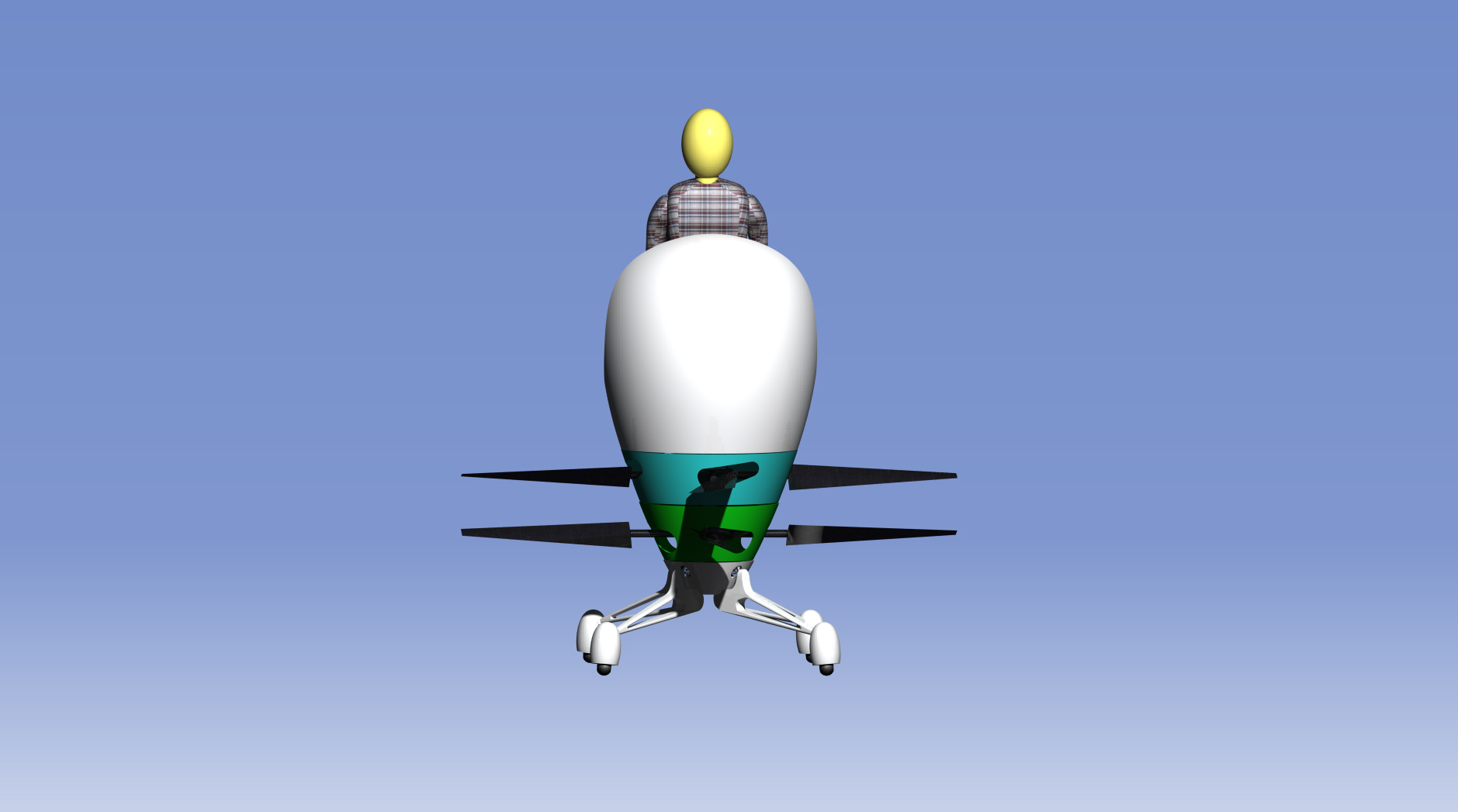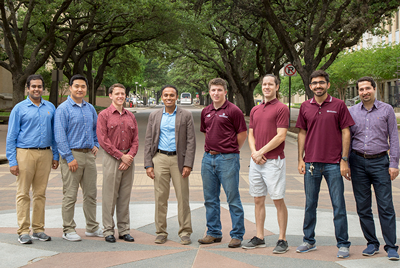
The GoFly Prize, a two-year, $2 million international competition to create a personal flying device, announced the 10 winners of Phase I of the challenge, including Team Texas A&M University led by Dr. Moble Benedict, assistant professor in the Department of Aerospace Engineering.
The competition, sponsored by Boeing, launched in September 2017 with almost 3,000 innovators across 95 countries competing in Phase I. GoFly tasked teams with creating a personal flying device that can safely be flown by anyone, anywhere, 20 miles without refueling or recharging with vertical, or near vertical, takeoff and landing capability.
Benedict’s team created “Harmony,” a compact rotorcraft designed to minimize noise and maximize efficiency, safety, reliability and flight experience. As one of the winning teams, they were awarded a $20,000 prize based on their written report.
“We decided to take part in the GoFly challenge because we think this is a great opportunity for us to contribute to the field of aviation by developing a safe, green and more importantly, truly practical personal air vehicle, which is something we have always dreamed of,” said Benedict. “This can provide a means of quick transportation for a single person from point A to B via air while experiencing the thrill of flying. This will be a paradigm shift in the way we look at air transportation today and will have huge benefits to the mankind in the future.”
The design process involved configuration selection to meet the strict design requirements of the GoFly challenge followed by a detailed design using in-house codes for rotor performance analysis and sizing, acoustic analysis, vehicle flight dynamics and control modeling, state-of-the-art legacy computational fluid dynamics codes for performance verification along with targeted experiments, and detailed drawings and composite blade structural design. They have also built and flight tested a 1/8th scale model of their vehicle.
“I'm really excited to be a part of the GoFly project because it is an outlet for creativity,” said team member David Coleman. “We have a really constrained design space and so we have to get creative in terms of shape, configuration and orientation. And we also want a vehicle that looks like you want to ‘go fly’ it.”
From the beginning of the project, the team worked through practical issues that needed to be overcome. The first of those was the size of the personal air vehicle (PAV); it had to be something small enough (max dimension less than 8.5 ft.) that you can just pull it out of your garage, take off vertically and fly it wherever you want.
“You want your PAV to be very compact,” said Benedict. “But then, there is a big trade-off between efficiency vs. compactness for a rotor. If you make a rotor very compact to reduce the footprint, you lose efficiency. That is the reason why helicopters rotors are very big. So we have carefully chosen a configuration that can give you very high efficiency for the given footprint.”
The next issue they addressed is noise. Benedict pointed out that many PAVs taking off from a neighborhood could be awfully loud. To combat this, the team uniquely shaped the blades to minimize the rotor noise as much as possible.
One of the goals of the GoFly competition is to have a vehicle that is very easy for anyone to fly, not just an experienced pilot. To overcome this hurdle, the team designed the control system in a way that is very stable and easy enough to be flown with very minimal training. Bochan Lee, a graduate researcher under Benedict, is helping to develop the control system based on seven years of South Korean Navy helicopter pilot experience.
“I'm so excited to participate in the Gofly Prize because it is a great opportunity to design and build the next generation unique flying vehicle,” Lee said.
Taking the safety of the pilot in to consideration, Benedict’s team chose a design where the pilot’s legs are nowhere close to the tip of a rotor blade. Their design also has the pilot seated above the rotor to provide him or her a great field of view, unconstrained by a canopy, adding to the thrill of flying, much like riding a motorcycle.
The team is now in the process of turning their design into a fully functioning flying prototype for Phase II. While they have built and flight-tested a wide range of vertical takeoff and landing unmanned aerial vehicles in the past, this vehicle is much bigger than anything they have ever done.
“There are some unique technical barriers we have identified, and those need to be overcome to make this a reality,” says Benedict. “We have a very motivated team, extremely passionate about vertical flight and this challenge in particular, and I am very confident that we can make it happen.”
Their biggest challenge right now is finding sponsors and raising money to build the prototype.
“I'm excited about GoFly because it's a rare opportunity for me to significantly contribute to aviation as a fresh graduate,” said team member Farid Saemi. ”I'm not just another cog in the corporate machine, I am the motor of an electric flying machine.”
Teams do not need to have submitted a design or won Phase I in order to compete in Phase II. Awards for Phase II will include four $50,000 prizes awarded to teams with the best prototypes in March 2019, and Phase III will unveil the grand-prize winner, awarded at the Final Fly-Off in the fall of 2019.
The Texas A&M Engineering Experiment Station Office of Commercialization and Entrepreneurship provided support to commercialize and further develop the team’s concept.

The 16 team members are listed below in alphabetical order:
Dr. Moble Benedict (captain) is an assistant professor of aerospace engineering and founder of Advanced Vertical Flight Laboratory (AVFL) with 15 years of experience in VTOL aircraft concepts. He was awarded the 2012 AIAA Young Engineer-Scientist Award, 2016 AHS Bagnoud Award and $25,000 grand prize at the Lockheed Martin Innovate the Future Global Challenge.
David Coleman is a doctoral student conducting research at AVFL on a robotic hummingbird concept, which he has designed, built and flight tested. He has won numerous awards for his work and was one of the semi-finalists for the 2018 MIT Lemelson Award.
Hunter Denton is a master’s student in AVFL. He has designed and built numerous small scale, coaxial helicopter systems including the GoFly proof of concept.
Nima Ershad is a doctoral student in the electrical and computer engineering department. He is experienced and interested in power electronics and its applications in motor drives, design, prototyping, and analysis of electrical machines and powertrains.
Dr. Bharath Govindarajan is an assistant research professor at the University of Maryland with a focus on rotorcraft aerodynamics and helicopter design. He has participated and won in the American Helicopter Society’s annual international design competition both as a graduate student and faculty advisor.
Dr. Eric Greenwood received a Ph.D. in aerospace engineering from the University of Maryland and is a researcher at NASA Langley developing rotor noise modeling methods and experimental techniques. He was awarded the NASA Early Career Achievement Medal in 2017 and the 2018 AHS Bagnoud award for this work.
Atanu Halder is pursuing his doctoral degree in aerospace engineering. He works at AVFL developing design framework of next generation VTOL UAVs based on a novel cyclorotor concept. He won best paper award at 2017 AHS Forum and Vertical Flight Foundation scholarship in 2018.
Adam Kellen is a master’s student in aerospace engineering. His specialties include mechanical design, CAD and experimental testing. For the past three years he has worked at AVFL to understand the scalability of a novel cyclorotor concept.
Dr. Vinod Lakshminarayan is a research scientist at Science and Technology Corporation, NASA Ames Research Center. He is one of the primary developers of the high-performance computational software, Helios, which is used for design and analysis of complex rotary wing systems at the Department of Defense and U.S. helicopter companies.
Bochan Lee has seven years of experience as a South Korean Navy UH-60 pilot and a current graduate researcher at AVFL working on autonomous helicopter ship landing. He won the 2018 Vertical Flight Foundation scholarship.
Andrew Riha is a master’s student in aerospace engineering working on boundary layer transition.
Carl Runco is a doctoral student at AVFL and has several years’ experience designing, creating and flying one-of-a-kind VTOL rotorcraft.
Farid Saemi is a doctoral student in aerospace engineering. He works at AVFL and his research is focused on developing physics-based motor, controller and battery models.
Dr. Ananth Sridharan is a research scientist at the University of Maryland, College Park. During the last 10 years, he has worked on several aspects of helicopter design including flight dynamics and control, vibration prediction, aeromechanics, design optimization and preliminary sizing.
Vishaal Subramanian is a master’s student in aerospace engineering. He has participated in SAE Aero Design competitions from 2014-16.
Aswathi Sudhir is a doctoral student in materials and structures in aerospace engineering. Her research focus is on computational damage mechanics in composite materials.